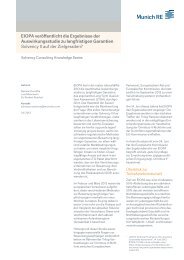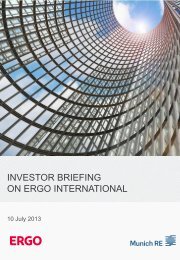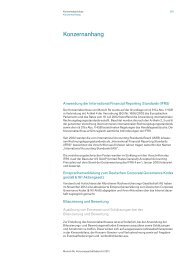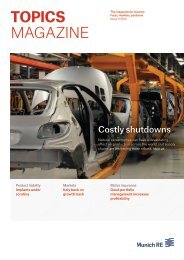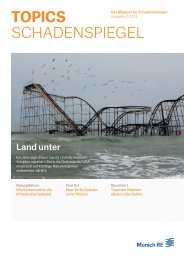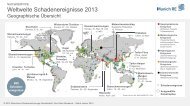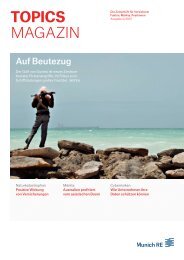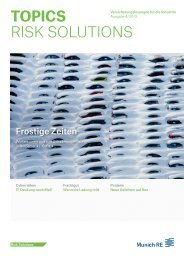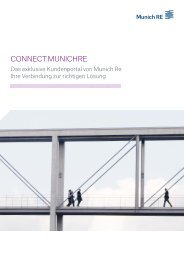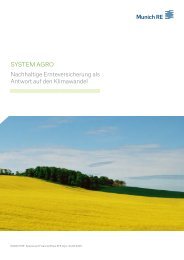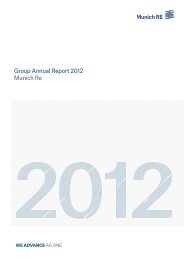Munich Re Group Annual Report 2006 (PDF, 1.8
Munich Re Group Annual Report 2006 (PDF, 1.8
Munich Re Group Annual Report 2006 (PDF, 1.8
You also want an ePaper? Increase the reach of your titles
YUMPU automatically turns print PDFs into web optimized ePapers that Google loves.
<strong>Munich</strong> <strong>Re</strong> <strong>Group</strong> <strong>Annual</strong> <strong>Re</strong>port <strong>2006</strong><br />
Chinese market. Rates for the renewed portfolio were<br />
slightly lower overall, but remain at a good profitability<br />
level.<br />
For the forthcoming renewals on 1 April (Japan and<br />
Korea) and 1 July (parts of the US market, Australia and<br />
Latin America), we expect a similarly stable environment<br />
to that prevailing for the renewals at 1 January 2007.<br />
Provided there are no strong movements in exchange<br />
rates, gross premium volume in reinsurance in 2007<br />
should total between €22bn and €23bn – roughly the same<br />
level as in the previous year. We estimate that positive<br />
developments in the growth markets will make up for the<br />
premium reductions associated with the shift from proportional<br />
to non-proportional forms of cover. In propertycasualty<br />
reinsurance, we expect a combined ratio of less<br />
than 97% based on a major-loss burden from natural catastrophes<br />
of 5% of our earned premiums. Altogether, we<br />
anticipate a profit for the year of around €2.3–2.6bn in<br />
reinsurance.<br />
Primary insurance<br />
The trends currently prevailing in the segments are likely<br />
to continue by and large in the coming year.<br />
In life insurance, our gross premiums written should<br />
increase slightly. Maturing policies, i.e. policies whose<br />
premium payment period has ended, continue to have a<br />
curbing effect on premium income. The rising demand for<br />
private provision and the high attractiveness of retirement<br />
provision products are being reflected in the figures for<br />
German new business. Here, we expect higher revenue<br />
from single premiums and a rise in regular-premium income,<br />
especially in unit-linked life insurance. The sale of<br />
Riester pension products qualifying for subsidisation should<br />
develop favourably and company pension business should<br />
also gather pace.<br />
We are proceeding on the assumption that premium<br />
development in the health segment will exceed market<br />
growth in 2007. Our product sales in supplementary health<br />
insurance should be further invigorated by the growing<br />
awareness among clients that they themselves must<br />
bridge the gaps in state health insurance coverage by<br />
taking out private insurance. Our planning for German<br />
comprehensive health cover is currently based on the<br />
assumption that the health reform’s introduction of a<br />
three-year waiting period for those wishing to switch over<br />
to private health insurance will impact new business devel-<br />
122<br />
Management report_Prospects<br />
opment negatively by approximately 15%. Business outside<br />
Germany should continue to develop strongly.<br />
Premium income in property-casualty insurance<br />
should grow significantly, mainly owing to good foreign<br />
business buoyed by the consolidation of the Turkish I . sviçre<br />
<strong>Group</strong>, which was included in our premium income in only<br />
one quarter of the past financial year. In Germany, premium<br />
development is likely to be weak. Although the<br />
significant decline in premium income in German motor<br />
insurance will not continue as hitherto and the economy<br />
strengthened considerably at the end of <strong>2006</strong>, the higher<br />
insurance tax and increased value-added tax, with its<br />
growth-curbing impact on the overall economy, will have a<br />
dampening effect in 2007. We aim to grow again in private<br />
and commercial property insurance and above all in personal<br />
accident insurance. As far as the result is concerned,<br />
we anticipate that we will be able to achieve a combined<br />
ratio which, despite a marginal increase, will still total less<br />
than 95% for the whole year in property-casualty business,<br />
including legal expenses insurance.<br />
All in all, gross premiums written by our primary insurers,<br />
which in addition to the ERGO Insurance <strong>Group</strong> essentially<br />
comprise Europäische <strong>Re</strong>iseversicherung and the<br />
Watkins Syndicate, should total between €17.0bn and<br />
€17.5bn in 2007, an increase of 1.5% to 4.5%.<br />
In 2007, we will adhere to the measures previously<br />
introduced to improve our result. Cost discipline remains<br />
a central issue for us, and we will consistently take advantage<br />
of further possibilities for reducing costs. Overall,<br />
we aim for a consolidated result in primary insurance of<br />
€600m to €750m. The fact that higher results were achieved<br />
in 2005 and <strong>2006</strong> was attributable to the exceptionally<br />
good investment result in both years and to the one-off tax<br />
effect in <strong>2006</strong>. We expect we will be able to maintain our<br />
successful course of the past few years in our operative<br />
business in 2007.<br />
Asset management<br />
The investment environment in <strong>2006</strong> was characterised by<br />
low interest rates and rising share prices.<br />
Since last year’s mid-year peak in interest rates, yields<br />
on long-term fixed-interest securities have declined again.<br />
Interest-rate developments in the USA, which resulted in<br />
an inverse interest-rate structure, have caused the yield<br />
curve in the eurozone to virtually level out.



